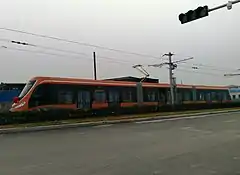Qingdao Tram
Qingdao Tram, is a tram system operating in Chengyang District, Qingdao, China. It first opened in 2016. The Qingdao Public Transport Group Rail Bus Co., Ltd. is responsible for its operation and management.
 | |
 | |
| Overview | |
|---|---|
| Locale | Qingdao, China |
| Transit type | Tram |
| Number of lines | 1 |
| Number of stations | 12 |
| Operation | |
| Began operation | 2016 |
| Operator(s) | Qingdao Public Transport Group Rail Bus Co., Ltd. |
| Reporting marks | QT |
| Technical | |
| System length | 9 km (5.6 mi) |
| Track gauge | Standard gauge 1,435 mm (4 ft 8 1⁄2 in) |
| Electrification | 750 V DC Overhead line |
History
In the 1920s, the Qingdao municipal government planned to build a tram to replace some of the buses. From 1938 to 1940, Kao Electric Co., Ltd. planned to cooperate with the government to build the tram together, and thus set up a "tram preparation office" in the Posts and Telecommunications Zhongshan Road Branch, but the Qingdao government observed that Qingdao's steep terrain slope and lack of friction between tramway tracks and wheels rendered it impractical to run trams, leading to the suspension of this plan.
In April 2013, Qingdao City, planning a length of about 6 km (3.7 mi) north-south tram lines, after the road conditions due to the plan to change the construction of east–west line in Chengyang District . As the first truly terrain construction project in EPC (Design-Procurement-Construction) mode in China, the project was planned to be completed in 2014 on the 15th of December. However, it was not completed on time. On December 17, for the community it was carried out the collection of vehicle signs, body color, and station name views of the activities. On December 28 morning it was planned no-load test run, then continue to line, vehicle, and signal system of the technical parameters of the test and adjustment, driving, crew business practice.
In June 2015, the project was announced by the China Transportation Enterprises Committee as "2015 annual transport enterprises low-carbon energy-saving environmental protection outstanding project." In October, the vehicle field center machine room axis shaft equipment debugging done, and with the line turnout control area joint test have done. On December 18, more than 40 representatives of the public were invited to try tram. In January 2016, it was scheduled to carry out tricycle test operation review. On February 5, the public was allowed to ride the tram as be free trial experience without ticket. On February 24, tricycle third expert review has done. On March 5, it began a formal passenger test operation. On November 8, the first seven cars on the line, full line with the car were in place.
Tram route and stops
- 1 – Chengyang Wholesale Market to Qianwangtuan
The tram route has a total length of 9 km (5.6 mi), all for the ground line. Line and the west side of the road with a shared road right, about 400 metres (1,300 ft), the rest of the road are semi-closed road right, that is, the interval between the exclusive right and the intersection of road right. There are seven hybrid substations, double insulated elastic suspension mesh, the rated voltage is 750 volts DC. The stops are - Qianwangtuan station, Tianwang Road station, Shuiku Park station, Huicheng Road Station, Qingwei Road station, Guocheng Road station, Chuncheng Road station, Changcheng Road station, Agricultural University station, Mingyang Road station, Zhengyang Road station, Chengyang Wholesale Market station, a total of 12 stops, of which Agricultural University is an interchange station with Line 1 (Qingdao Metro). The route will be extended to the west to Chengyang railway station.
Practical information
- Total length - 9 km (5.6 mi)
- Opened - 5 March 2016
- Number of Stops - 12
- Number of routes - 1
- Gauge - Standard Gauge
Fleet
The tram is a Škoda 15 T produced by CRRC Qingdao Sifang. The vehicle body is 2.65 m (8 ft 8 in) wide, and 35.19 m (115 ft 5 in) long. The trams have a modular design with streamlined ends and a maximum running speed of 70 km/h (43 mph). Vehicles are bi-directional and have 3 articulated sections with a total of 6 doors per side of each vehicle. The total passenger volume of each tram is over 300 people. The trams are low-floor, with the car floor 35 cm (14 in) above the ground.
Depots
The system set up a depot – Qianwangtuan depot, covers an area of 2 hectares (5 acres), located in the eastern end of the line at Chunyang Road and at the northwest corner of Fenghuangshan Road junction. The depot could bear the early arrival of the vehicle with the annual inspection, weekly inspection, check, parking, and daily maintenance and so on. One or two repair work commissioned by the vehicle manufacturers to complete the Quartet.
Alignment and interchanges
The modern tram routes completely run on reserved grass-bed track at middle of the road.
Ride and ticketing system
The tram system uses a manual scheduling management model. Each tram is assigned one driver and three crew members, all of whom are under 35 years old and have at least two years of experience. Passengers pay upon boarding, either with coins or by swiping a card. The one-way fare is 2 yuan.